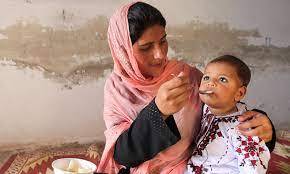The agriculture sector of Pakistan contributes 18.9% to GDP and employees 42.3% of the labor forces, including women. The estimates suggested that half of country’s population still resides in rural areas and directly dependent on the agriculture, including production of wheat, cotton, sugarcane, rice, mangoes, dates and kinnow. Yet, it faces a huge food crisis because of rapidly growing population and insufficient food productivity. Pakistan is currently at 92nd rank out of 116 nations in Global Hunger Index. A report by IPCINFO, which conducted survey in districts of Baluchistan, Khyber-Pakhtunkhwa and Sindh, highlighted that all these areas are facing high prevalence of food insecurity, malnutrition and poverty.
The unprecedented floods of 2022 have made the situation worse as one-third of the country went underwater, caused 1,700 casualties and affected around 33 million people, and the country needs $16 billion to recover. “Around 17 million women and children are at risk of preventable disease,” the report mentioned. Women are considered vital part of the agricultural sector in Pakistan, but gender-based inequalities are huge i.e., land ownership, accessing inputs, extension and financial services. A study by the International Food Policy Research Institute found that, in Pakistan, climate change is projected to cause a decline in agricultural yields of up to 40% by 2050, further exacerbating food insecurity for women.
Women are one of the most affected by the 2022 floods as recounted in stories of different women. Asmat Jaskani, a farm worker said flooding destroyed wheat fields that used to provide her income. “After the floods, the earning from our wheat crop is now half, as we are thirty people in our house, and we don’t have any savings from the harvest, so how will we eat?” Another farm worker from Sindh, Sakeena Gadhi said that only one wheat crop is cultivated in their village, flood washed away our homes and after staying in tents for 10 months, we are back in our village but there is nothing here.”
There are hundreds of such stories in the flood-hit areas and the situation doesn’t seem to improve as Climate Risk Country Profile, projections for Pakistan for the next 10 years suggest, “yield declines in many key food and cash crops, including cotton, wheat, sugarcane, maize and rice”. This means the country needs to work on emergency footings to counter the looming threat of food insecurity. One of the solutions is to recognize women’s informal labour.
“Provision of better and flexible financial services, withdrawing mobility restrictions, flexible access to markets, the introduction to technological and entrepreneurial skills and promotion of women’s association in farm organization can improve the agricultural yields by 20% to 30%,” suggested Nadia Agha, the director of the Institute of Gender Studies, Shah Abdul Latif University, Khairpur.
Analysts insist that without recognizing the women’s role and current plight in this serious issue, it would be impossible to find a solution for the government. Hence, a recognized, independent and government policy-supported model for women in the agricultural sector especially is the primary way to resolve the issue and tackle the problem of food insecurity, and obviously a serious policy on climate change will resolve the overall problem.
“Our policymakers are aware of the problems related to food insecurity among our populace, but the most important elements, which include water, climate, and agriculture, do not find the right place on the priority list of our national objectives,” notes analyst and author Dr Zia Ul Haque Shamsi.






